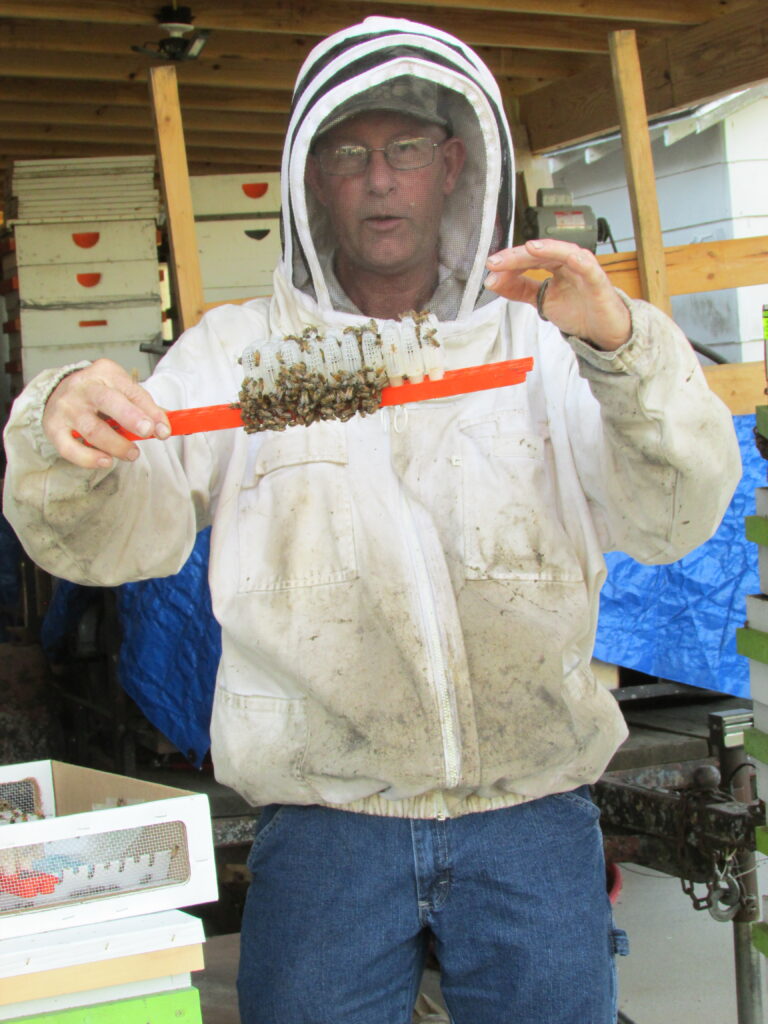Local beekeeper suffers unusual loss of hives

By Sheila Harris sheilaharrisads@gmail.com
Beekeeper Kevin Young and his wife Bonita, of Exeter — marketers of K&B Honey — lost 85 percent of their beehives over the winter due to circumstances no one is able to explain, least of all Kevin Young, who has kept bees for over 20 years.
“Going into winter, I had 225 hives; each of those hives had about 50,000 bees in it,” Young said. “When I began opening the hives up in early April, I discovered that most of the bees were gone. All that was left was a handful of dead bees, with maybe one living bee.”




The odd thing, says Young, is that all of the combs were full of honey, which would not be the case if the bees had left because they were facing starvation, a common plight for some bees during winter months.
Amy Patillo, with the University of Missouri Extension’s Southwest Research Center, where she’s in charge of an apiary for a Missouri Heroes to Hives chapter, says average hive losses during the winter, statewide, is usually around the 20 percent mark, although this past winter was closer to 50 percent for some beekeepers, due to drought.
Young began his apian venture 20 years ago, when he purchased two hives from a man in Kansas, where he had traveled to buy a planer for his woodworking shop. With education and careful management, beekeeping became more than just a hobby for the Youngs. With Bonita Young serving as the marketer for honey sales, K&B Honey became available for purchase in retail outlets within a wide radius of Exeter over the ensuing years, and rare was the Saturday morning that Bonita wasn’t vending honey at the Garden Sass Farmer’s Market in Cassville.
Honey sales, though, Kevin Young said, are but a portion of the financial opportunities provided by an apiary. Every year, Young buys 110 new queen bees from an outof- state breeder.
Depending on the strain or breed, prices for queens can range anywhere from $20 to $100 per bee, say online sources, although the average price is between $20 and $40 each.
“I split my bee colonies and start new hives every year,” Young said. “Each new hive gets one of the new queens.”
A queen bee is the focal point of every hive. Thousands of sterile female worker bees essentially live to serve her, as well as tend to all of the needs of the hive, including foraging for food and carrying water. Typically, foraging occurs within a two-mile radius of the hive, although distances up to six miles have been noted by entomologists.
Young typically keeps part of the new hives he splits, and sells the remainder to other beekeepers around the nation, many who drive from long distances to purchase his starter hives, or “nucs.” By selling these “splits,” Young is able to recoup the price he pays for the new queens, plus make enough profit to continue in the business that has long fascinated him.
This year, Young had already ordered and paid for 110 queen bees before he realized that his worker bees had abandoned their hives, leaving him without a sufficient worker bee population to make the splits needed to start new hives.
“I have a few beekeeping friends who were able to buy some of the new queens from me so they’d have a place to go,” Young said.
He plans to split his few remaining colonies in order to use some of the fresh queens, but his hive count will be a far cry from the additional 100 or more hives he had hoped to add this year to bring his total up to well over 300.
“This spring and summer will be like starting all over again,” he said.
Young is at a loss as to the reason for his “Colony Collapse Disorder (CCD),” as the abandonment of his hives is called by entomologists.
He wonders if the bees’ disappearance might be associated with the poultry- processing waste residuals being land-applied in the areas where his hives are located.
“With the permission of landowners, I put about 12 hives each on different properties within a five-mile radius of Exeter,” he said. “Each of those properties was in an area where poultry-processing residuals were being applied. I don’t know whether that has anything to do with the bees disappearing or not.”
Although Young says he just doesn’t know, he also says it’s the only change in the bees’ environment over the past year.
Varroa mites — the number one culprit for destroying hives by sucking the blood of bees and their larvae — were ruled out. So, too, was pesticide poisoning.
“If bees are poisoned by a pesticide, they usually die in or near the hive and you’ll find piles of dead bees,” Young said. “Nothing like that happened here. The bees were just gone, with maybe a few dead ones in the hive.”
Theories have been postulated regarding plants and water contaminated by ingredients in the poultry processing residuals, but without concrete knowledge of exactly what’s in the residuals, a firm answer seems elusive.
“I do know what we put on the ground is taken up in the plants,” Young said. “Otherwise, we wouldn’t use fertilizer. And bees feed on the nectar from those plants and carry it back to the hives.”
Young says worker bees will sometimes leave the hive if they’re not feeling well in an attempt to protect the remainder of the hive from disease.
Professor Scott McArt, associate director of the Department of Entomology at Cornell University, says it’s possible the bees may have vacated the area because of the smell of the processing residuals, which has been described as “almost vomit-inducing” by neighboring landowners.
Bee-Go-N, a product used by some beekeepers to clear bees out of honey storage trays in hives (supers) so that honey can be harvested, has the active component n-butyric anhydride. Butyric anhydride is similar in smell, says Professor McArt, to butyric acid.
Butyric acid, created in the guts of humans and animals when bacteria break down dietary fiber, serves an important digestive function. It does, however, say those in the know, smell like vomit.
While McArt couldn’t say definitively that Young’s bees absconded because of the putrid smell of digestive remnants being applied to their habitat, “It certainly seems possible that the bees wouldn’t be happy about it,” he said.
Amy Patillo, with the MU Extension, is not familiar with the land-application of poultry-processing residuals, nor how they might affect bees.
Anna Schoelzel, who, along with her husband, owns and maintains hives at Buckley’s Bees, northeast of Cassville, said she experienced about a 50 percent loss of her hives over the winter. She attributes that loss to starvation.
“With the warm-ups and cool-downs this past winter, the bees tried to leave their hives too early and were unable to find food,” she said.
Schoelzel said, as far as she knows, poultry processing residuals have not been land applied close to the area where she lives.
Kevin Young may never learn for sure why his bees left home, but he hopes that in sharing his story, someone may be able to provide answers.
Cassville realtor Joy Chappell, a friend of the Youngs, hopes their story prompts people to question changes they notice in the environment around them.




